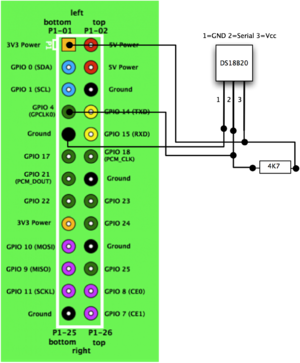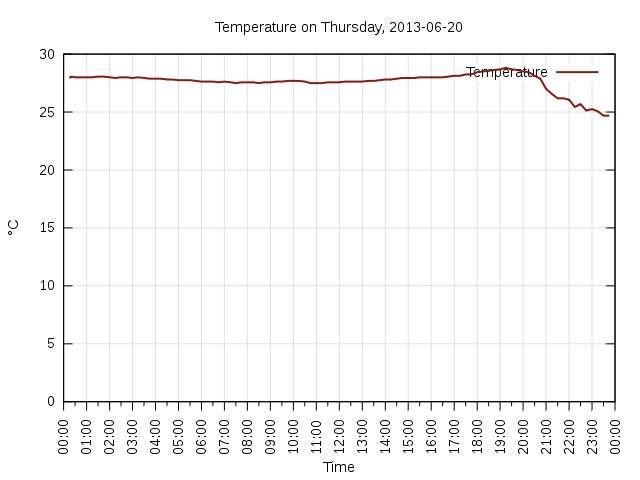RaspberryPi Temperature Sensor
Time to build a temperature sensor with my Pi.
Schematics

Remember that the Pi revisions have different pinouts! This will work for Revison 2, that is board revision 0004[1]. If you also want to measure humidity and don't need decimal degrees, take a look at RaspberryPi Humidity and Temperature Sensor which uses a DHT11 instead of a DS18B20. But the DHT11 has another disadvantage: There's no kernel module for the Pi for the DHT11 for 1-wire.
Configure the Pi
Update the OS
This not necessary, but generally a good idea.
apt-get update apt-get upgrade
Install missing packages
If you have already installed them, you can skip this step.
apt-get install bc apt-get install gnuplot
Setup kernel modules for GPIO and 1-wire device
modprobe w1-gpio modprobe w1-therm
That maps /sys/bus/w1, you might want to do: vi /etc/modules and add the modules
Check setup
Check whether there is now our sensor device:
cd /sys/bus/w1/devices ls -1
(if not you might want to try adding dtoverlay=w1-gpio to /boot/config.txt and reboot)
10-000802ad5087[2] w1_bus_master1
See it's content (values):
cd 10-000802ad5087[3] cat w1_slave
39 00 4b 46 ff ff 03 10 9c : crc=9c YES 39 00 4b 46 ff ff 03 10 9c t=28562[4]
Code
This is how I read the device and generate a nice plot using GNUplot:
#!/bin/bash
#set -x
#
# Script: readTemperature.sh
# Author: Heiko Kretschmer
# Purpose: Reading the temperature and generating a nice plot
#
#
#
# Globals
#
GDEVICEID="10-000802ad5087"
GDEVICESPATH="/sys/bus/w1/devices"
GDEVICEVALUEFILE="w1_slave"
GTIMESTAMPFORMAT="%Y-%m-%d_%H:%M"
GTIMESTAMP="`date +${GTIMESTAMPFORMAT}`"
GTIMESTAMPTIME="`date '+%H:%M'`"
GTIMESTAMPDATE="`date '+%Y-%m-%d'`" # ISO 8601 date format
GTIMESTAMPDATEHUMANREADABLE="`date '+%A, %Y-%m-%d'`"
GFOLDERBASE="/home/pi/Development/temperature"
GFOLDERLOGS="${GFOLDERBASE}/logs"
GFOLDERGRAPHS="${GFOLDERBASE}/graphs"
GFOLDERTMP="${GFOLDERBASE}/tmp"
GFILELOG="${GFOLDERLOGS}/readTemperature_${GTIMESTAMPDATE}.log"
GFILEGRAPH="${GFOLDERGRAPHS}/readTemperature_${GTIMESTAMPDATE}.svg"
GFILEPLOTCOMMANDS="${GFOLDERTMP}/readTemperature-plot.cmd"
#
# Main
#
# Init
test ! -d "${GFOLDERLOGS}" && mkdir "${GFOLDERLOGS}"
test ! -d "${GFOLDERGRAPHS}" && mkdir "${GFOLDERGRAPHS}"
test ! -d "${GFOLDERTMP}" && mkdir "${GFOLDERTMP}"
# Get the temperature
VALUERAW="`cat \"${GDEVICESPATH}/${GDEVICEID}/${GDEVICEVALUEFILE}\" | grep t= | cut -d= -f2`"
VALUE="`echo \"scale = 3; ${VALUERAW} / 1000\" | bc`"
#echo Temperature: ${VALUE}
# Write it into the log (one logfile per day to get nice graphs)
echo -e "${GTIMESTAMPTIME}\t${VALUE}" >> "${GFILELOG}"
# Generate the graph
test -f "${GFILEPLOTCOMMANDS}" && rm "${GFILEPLOTCOMMANDS}"
echo "reset" >> "${GFILEPLOTCOMMANDS}"
echo "set key inside right top vertical Right noreverse enhanced autotitles columnhead nobox" >> "${GFILEPLOTCOMMANDS}"
# Set time format for X axis
echo "set timefmt \"%H:%M\"" >> "${GFILEPLOTCOMMANDS}"
echo "set xdata time" >> "${GFILEPLOTCOMMANDS}"
echo "set format x \"%H:%M\"" >> "${GFILEPLOTCOMMANDS}"
# Setup line style (#1) for the temperature line
echo "set style line 1 lc rgb '#8b1a0e' pt 1 ps 1 lt 1 lw 2" >> "${GFILEPLOTCOMMANDS}" # http://www.gnuplotting.org/tag/grid/
echo "set style data lines" >> "${GFILEPLOTCOMMANDS}"
# Set X tics (one tic per hour, rotate that tick-labels by 90 deg and move em a bit)
echo "set xtics \"01:00\" rotate by 90 offset 0,-2 out nomirror" >> "${GFILEPLOTCOMMANDS}"
# Setup Grid (with line style #12)
echo "set style line 12 lc rgb '#E0E0E0' lt 0 lw 1" >> "${GFILEPLOTCOMMANDS}" # http://www.gnuplotting.org/tag/grid/
echo "set grid back ls 12" >> "${GFILEPLOTCOMMANDS}" # http://www.gnuplotting.org/tag/grid/
# Setup Title
echo "set title \"Temperature on ${GTIMESTAMPDATEHUMANREADABLE}\"" >> "${GFILEPLOTCOMMANDS}"
# Label X and Y Axis
echo "set ylabel \"°C\"" >> "${GFILEPLOTCOMMANDS}"
echo "set xlabel \"Time\" offset 0,-0.5" >> "${GFILEPLOTCOMMANDS}"
# Setup Y range
echo "set yrange [ 0.000 : ] noreverse nowriteback" >> "${GFILEPLOTCOMMANDS}"
# Set output file type to svg and plot it into file
echo "set term svg size 640,480" >> "${GFILEPLOTCOMMANDS}"
echo "set output \"${GFILEGRAPH}\"" >> "${GFILEPLOTCOMMANDS}"
echo "plot \"${GFILELOG}\" using 1:2 title 'Temperature' with l ls 1" >> "${GFILEPLOTCOMMANDS}"
cat "${GFILEPLOTCOMMANDS}" | gnuplot
You might want to use a cronjob like this:
*/15 * * * * /home/pi/Development/temperature/readTemperature.sh > /dev/null 2>&1
Resulting graph
- More like this
- Links
- Where I got the ideas from: http://www.raspberrypi-spy.co.uk/2013/03/raspberry-pi-1-wire-digital-thermometer-sensor/
- Where I learned to use xticks: http://psy.swansea.ac.uk/staff/carter/gnuplot/gnuplot_time.htm
- Nice to know: How to setup timezones: dpkg-reconfigure tzdata
- About various methods of connecting 1-wire devices: http://www.fhemwiki.de/wiki/Raspberry_Pi_und_1-Wire and http://blog.gegg.us/2013/03/4-different-methods-of-1-wire-access-on-raspberry-pi/
- Where this will be used: Tomat-O-Mat
- More about Raspberry Pi on this website
- Footnotes:
- ↑ Raspberry Board Revision Check
- ↑ This will differ, since this is the UID of my device.
- ↑ This will differ, since this is the UID of my device.
- ↑ This is the temperature in degrees celsius (multiplied by 1000), therefore I have 28.562°C in my living room. OMG! It's frickin' hot!
